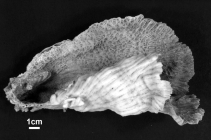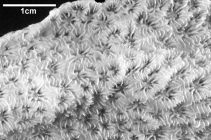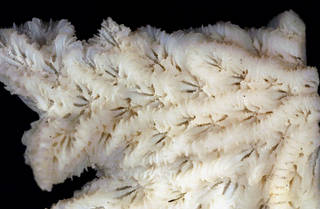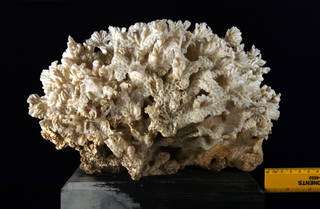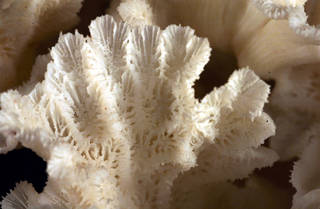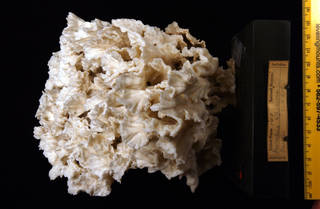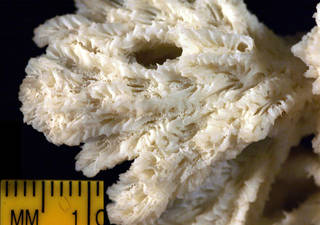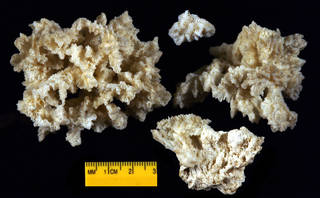
| Intro | | About | | Wiki | | Search traits | | Data explorer | | Literature | | Definitions | | Sources | | Webservices | | Statistics | | Feedback | | Editors | | Log in |
WoRMS taxon detailsMerulina ampliata (Ellis & Solander, 1786)
207407 (urn:lsid:marinespecies.org:taxname:207407)
accepted
Species
Agaricia ampliata (Ellis & Solander, 1786) · unaccepted > superseded combination
Agaricia flabellina Lamouroux, 1821 · unaccepted > junior subjective synonym
Madrepora ampliata Ellis & Solander, 1786 · unaccepted > superseded combination (basionym)
Merulina ampliata var. granulosa Chevalier, 1975 · unaccepted > junior subjective synonym
Merulina ampliata var. pachytheca Chevalier, 1975 · unaccepted > junior subjective synonym
Merulina ampliata var. ramosa Milne Edwards & Haime, 1851 · unaccepted > junior subjective synonym
Merulina ampliata var. vaughani Van der Horst, 1921 · unaccepted > junior subjective synonym
Merulina amplita (Ellis & Solander, 1786) · unaccepted > misspelling - incorrect subsequent spelling
Merulina crispa Dana, 1846 · unaccepted > junior subjective synonym
Merulina ramosa Milne Edwards & Haime, 1851 · unaccepted > junior subjective synonym
Merulina regalis Dana, 1846 · unaccepted > junior subjective synonym
Merulina speciosa Dana, 1846 · unaccepted > junior subjective synonym
Merulina vaughani Van der Horst, 1921 · unaccepted > junior subjective synonym
Mycedium ampliatum (Ellis & Solander, 1786) · unaccepted > superseded combination
marine,
recent + fossil
(of Madrepora ampliata Ellis & Solander, 1786) Ellis, J.; Solander, D. (1786). The Natural History of many curious and uncommon Zoophytes, collected from various parts of the Globe. Systematically arranged and described by the late Daniel Solander. 4.(Benjamin White & Son: London): 1-206, pls 1-63., available online at https://www.biodiversitylibrary.org/page/41943909 [details]
Holotype (of Madrepora ampliata Ellis & Solander,...
Holotype (of Madrepora ampliata Ellis & Solander, 1786) GLAHM 104015, verbatimGeounit 'les mers de l'Inde'... [details] Unreviewed
Type locality unrecorded (Veron, 1986). [details]
Description This has small colonies which commonly exceed 1 metre across and 0.5 metres tall; they are a mixture of foliaceous plates...
Description This has small colonies which commonly exceed 1 metre across and 0.5 metres tall; they are a mixture of foliaceous plates and contorted projections. These contortions resemble a mass of irregular branches in some colonies. Calices on the leafy parts of a corallum are rarely monocentric, but usually run in long meandroid series toward the edge of the leaf. Corallites on the twisted projections are commonly monocentric. Walls are low, rounded and very broad relative to the calice width. Merulina ampliata lives in mid to deep water depths on all reef slopes. It is usually pale yellow or brown, commonly tinted with pink. (Sheppard, 1998 <308>) Colonies are laminar and foliaceous or sub-arborescent with different growth forms characteristically occurring in the one colony. Valleys are short, straight and spread fan-wise, then divide. They radiate from the colony centre on flat surfaces but are highly contorted on branches. Flat surfaces often have concentric growth lines. Polyps are usually extended only at night. Colour: a variety of pale colours, usually pink or pale brown. Abundance: common. Occurs in a wide variety of reefal habitats but is most abundant in lagoons. (Veron, 1986 <57>) Radial, toothed ridges decorate the colonies which are variable in growth form ranging from fan-like plates to contorted, foliaceous branches within the same colony. Colour: varies from pale pink to light brown. Habitat: diverse. (Richmond, 1997) [details]
Hoeksema, B. W.; Cairns, S. (2025). World List of Scleractinia. Merulina ampliata (Ellis & Solander, 1786). Accessed through: World Register of Marine Species at: https://www.marinespecies.org/aphia.php?p=taxdetails&id=207407 on 2025-07-16
Date action by
Nomenclatureoriginal description
(of Merulina regalis Dana, 1846) Dana, J.D. (1846-1849). Zoophytes. United States Exploring Expedition during the years 1838-1842. <em>Lea and Blanchard, Philadelphia.</em> 7: 1-740, 61 pls. (1846: 1-120, 709-720; 1848: 121-708, 721-740; 1849: atlas pls. 1-61)., available online at https://www.biodiversitylibrary.org/page/18989497, http://www.sil.si.edu/digitalcollections/usexex/navigation/ScientificText/USExEx19_08select.cfm [details] original description (of Madrepora ampliata Ellis & Solander, 1786) Ellis, J.; Solander, D. (1786). The Natural History of many curious and uncommon Zoophytes, collected from various parts of the Globe. Systematically arranged and described by the late Daniel Solander. 4.(Benjamin White & Son: London): 1-206, pls 1-63., available online at https://www.biodiversitylibrary.org/page/41943909 [details] original description (of Merulina vaughani Van der Horst, 1921) van der Horst, C.J. (1921). The Madreporaria of the Siboga expedition: 2. Madreporaria Fungida. Siboga-Expeditie: uitkomsten op zoölogisch, botanisch, oceanographisch en geologisch gebied verzameld in Nederlandsch Oost-Indië 1899-1900 aan boord H.M. Siboga onder commando van Luitenant ter Zee 1e kl. G.F. Tydeman, XVIb. E.J. Brill: Leiden. 53-98, plates I-VI pp. (look up in IMIS) [details] original description (of Merulina crispa Dana, 1846) Dana, J.D. (1846-1849). Zoophytes. United States Exploring Expedition during the years 1838-1842. <em>Lea and Blanchard, Philadelphia.</em> 7: 1-740, 61 pls. (1846: 1-120, 709-720; 1848: 121-708, 721-740; 1849: atlas pls. 1-61)., available online at https://www.biodiversitylibrary.org/page/18989497, http://www.sil.si.edu/digitalcollections/usexex/navigation/ScientificText/USExEx19_08select.cfm [details] original description (of Merulina speciosa Dana, 1846) Dana, J.D. (1846-1849). Zoophytes. United States Exploring Expedition during the years 1838-1842. <em>Lea and Blanchard, Philadelphia.</em> 7: 1-740, 61 pls. (1846: 1-120, 709-720; 1848: 121-708, 721-740; 1849: atlas pls. 1-61)., available online at https://www.biodiversitylibrary.org/page/18989497, http://www.sil.si.edu/digitalcollections/usexex/navigation/ScientificText/USExEx19_08select.cfm [details] original description (of Merulina ramosa Milne Edwards & Haime, 1851) Milne Edwards H, Haime J. (1851). Recherches sur les polypiers. Mémoire 6. Monographie des Fongides. <em>Annales des Sciences Naturelles, Zoologie, Series 3.</em> 15: 73-144. [details] original description (of Merulina ampliata var. pachytheca Chevalier, 1975) Chevalier JP. (1975). Les Scléractiniaires de la Mélanésie Française (Nouvelle-Caledonie, Iles Chesterfield, Iles Loyauté, Nouvelles Hébrides). II. Expedition Française sur les Récifs Coralliens Nouv.-Calédonie. 7: 1-407, pls. 1-42. Paris. [details] original description (of Merulina ampliata var. granulosa Chevalier, 1975) Chevalier JP. (1975). Les Scléractiniaires de la Mélanésie Française (Nouvelle-Caledonie, Iles Chesterfield, Iles Loyauté, Nouvelles Hébrides). II. Expedition Française sur les Récifs Coralliens Nouv.-Calédonie. 7: 1-407, pls. 1-42. Paris. [details] original description (of Agaricia flabellina Lamouroux, 1821) Lamouroux JVF. (1821). Exposition méthodique des genres de l'ordre des polypiers: avec leur description et celle des principales espèces, figurées dans 84 planches, les 63 premières appartenant à l'Histoire naturelle des zoophytes d'Ellis et Solander. <em>Paris 1821.</em> pp. 1-115, pls. 1-84., available online at https://www.biodiversitylibrary.org/page/50899961 [details] basis of record Veron JEN. (1986). Corals of Australia and the Indo-Pacific. <em>Angus & Robertson Publishers.</em> [details] new combination reference Ehrenberg, C. G. (1834). Beiträge zur physiologischen Kenntniss der Corallenthiere im allgemeinen, und besonders des rothen Meeres, nebst einem Versuche zur physiologischen Systematik derselben. <em>Abhandlungen der Königlichen Akademie der Wissenschaften, Berlin.</em> 1: 225-380., available online at https://www.biodiversitylibrary.org/page/29725862 [details] Othercontext source (Hexacorallia)
Fautin, Daphne G. (2013). Hexacorallians of the World. (look up in IMIS) [details]
additional source Ortmann, A. (1889). Beobachtungen an Steinkorallen von der Südküste Ceylons. <em>Zoologische Jahrbüchern, Abteilung für Systematik, Biologie und Biogeographie der Tiere.</em> 4: 493-590, pls. 11-17. page(s): 517, 540 [details] additional source Hoffmeister, J.E. (1925). Some corals from America Samoa and the Fiji Islands. <em>Papers from the Department of Marine Biology of the Carnegie Institution of Washington.</em> 22: 1-90, pls. 1-23. page(s): 31 [details] additional source Vaughan TW. (1918). Some shallow-water corals from Murray Island (Australia), Cocos-Keeling Island, and Fanning Island. <em>Papers from the Department of Marine Biology of the Carnegie Institution of Washington.</em> 9 (213): 49-234, pls. 20-93. [details] additional source Verrill, A. E. (1864). List of the polyps and corals sent by the Museum of Comparative Zoology to other institutions in exchange, with annotations. <em>Bulletin of the Museum of Comparative Zoology.</em> 1: 29-60., available online at https://www.biodiversitylibrary.org/page/6587563 page(s): 56 [details] additional source Dana, J.D. (1846-1847). On Zoophytes. <em>The American Journal of Science and Arts, Second Series.</em> 2(4): 64-69; 2(5): 187-202; 3(7): 1-24; 3(8): 160-163; 3(9): 337-347. New-Haven., available online at https://www.biodiversitylibrary.org/page/28135503 page(s): 271, 272-273 [details] additional source Cairns, S.D., B.W. Hoeksema & J. van der Land. (1999). Appendix: List of extant stony corals. <em>Atoll Research Bulletin.</em> 459: 13-46. page(s): 34 [details] additional source Volpi, C., Benvenuti D., 2003. The Duchassaing & Michelotti collection of Caribbean corals: status of the types and location of the specimens. Atti della Societa Italiana di Scienze Naturali e del Museo Civico di Storia Naturale in Milano 144 1: 51-74. page(s): 62 [details] additional source Randall RH. (2003). An annotated checklist of hydrozoan and scleractinian corals collected from Guam and other Mariana Islands. <em>Micronesica.</em> 35-36: 121-137. page(s): 134 [details] additional source Cairns, S.D., B.W. Hoeksema & J. van der Land. (2007). as a contribution to UNESCO-IOC Register of Marine Organisms. (look up in IMIS) [details] additional source Liu, J.Y. [Ruiyu] (ed.). (2008). Checklist of marine biota of China seas. <em>China Science Press.</em> 1267 pp. (look up in IMIS) [details] Available for editors additional source Veron JEN, Pichon M. (1980). Scleractinia of Eastern Australia – Part III. Family Agariciidae, Siderastreidae, Fungiidae, Oculinidae, Merulinidae, Mussidae, Pectinidae, Caryophyllidae, Dendrophylliidae. <em>Australian Institute of Marine Science Monograph Series.</em> 4: 1-459. [details] additional source van der Horst, C.J. (1921). The Madreporaria of the Siboga expedition: 2. Madreporaria Fungida. Siboga-Expeditie: uitkomsten op zoölogisch, botanisch, oceanographisch en geologisch gebied verzameld in Nederlandsch Oost-Indië 1899-1900 aan boord H.M. Siboga onder commando van Luitenant ter Zee 1e kl. G.F. Tydeman, XVIb. E.J. Brill: Leiden. 53-98, plates I-VI pp. (look up in IMIS) page(s): 4, 38, 43, 45 [details] additional source Veron JEN. (2000). Corals of the World. Vol. 1–3. <em>Australian Institute of Marine Science and CRR, Queensland, Australia.</em> [details] additional source Gardiner JS. (1905). Madreporaria III. Fungida IV. Turbinolidae. <em>Fauna and geography of the Maldives and Laccadives Archipelagoes, Cambridge.</em> 2: 933-957, pls. 89-93. page(s): 789, 790, Pl. LXIV [details] additional source Studer T. (1878). Übersicht der Steinkorallen aus der Familie der Madreporaria aporosa, Eupsammina und Turbinaria, welche auf der Reise S.M.S. Gazelle um die Erde gesammelt wurden. <em>Monatsberichte der Königlichen Preussischen Akademie der Wissenschaften zu Berlin.</em> 1877: 625-655, pls. 1-4. page(s): 644 [details] additional source Thiel, M.E. (1932). Madreporaria. Zugleich ein Versuch einer vergleichenden Oekologie der gefundenen Formen. Resultats scientifiques du Voyage aux Indes Orientales Neerlandaises. <em>Memoires du Musée Royal d'Histoire Naturelle de Belgique.</em> 2(12): 1-177, pls. 1-21. [details] Available for editors additional source Budd AF, Fukami H, Smith ND, Knowlton N. (2012). Taxonomic classification of the reef coral family Mussidae (Cnidaria: Anthozoa: Scleractinia). <em>Zoological Journal of the Linnean Society.</em> 166 (3): 465-529., available online at https://doi.org/10.1111/j.1096-3642.2012.00855.x [details] additional source Umbgrove JHF. (1940). Madreporaria from the Togian Reefs (Gulf of Tomini, North-Celebes. <em>Zoologische Mededelingen, Leiden.</em> 22: 265-310. page(s): 271, 285, 286 [details] additional source Umbgrove JHF. (1939). Madreporaria from the Bay of Batavia. <em>Zoologische Mededelingen, Leiden.</em> 22: 1-64. page(s): 14, 15, 18, 35-36 [details] additional source Yabe H, Sugiyama T, Eguchi M. (1936). Recent reef-building corals from Japan and the South Sea Islands under the Japanese mandate. I. <em>The Science reports of the Tôhoku Imperial University, Sendai, 2nd Series (Geologie).</em> Special Volume 1: 1-66, pls. 1-59. page(s): 3, 41, Pl. XXIX, Pl. LI [details] additional source Matthai G. (1928). A Monograph of the Recent meandroid Astraeidae. <em>Catalogue of the Madreporarian Corals in the British Museum (Natural History).</em> 7: 1-288, pls. 1-72. [details] Available for editors additional source Yabe H, Sugiyama T. (1935). Revised list of the reef-corals from the Japanese seas and of the fossil reef corals of the raised reefs and the Ryukyu limestone of Japan. <em>Journal of the Geological Society of Japan.</em> 42: 379-403. page(s): 386, 395 [details] additional source Best MB, Suharsono. (1991). New observations on scleractinian corals from Indonesia: 3. Species belonging to the Merulinidae with new records of Merulina and Boninastrea. <em>Zoologische Mededelingen, Leiden.</em> 65: 333-342. [details] additional source Duchassaing P, Michelotti J. (1860). Mémoire sur les coralliaires des Antilles. <em>Mémoires de l'Academie des Sciences de Turin, séries 2.</em> 19: 279-365, pls 1-10., available online at https://www.biodiversitylibrary.org/page/12140332 [details] additional source Dana, J.D. (1846-1849). Zoophytes. United States Exploring Expedition during the years 1838-1842. <em>Lea and Blanchard, Philadelphia.</em> 7: 1-740, 61 pls. (1846: 1-120, 709-720; 1848: 121-708, 721-740; 1849: atlas pls. 1-61)., available online at https://www.biodiversitylibrary.org/page/18989497, http://www.sil.si.edu/digitalcollections/usexex/navigation/ScientificText/USExEx19_08select.cfm [details] additional source Pillai CSG, Scheer G (1976) Report on the stony corals from the Maldive Archipelago. Results of the Xarifa Expedition 1957/58. Zoologica, Stuttgart 43 (126): 1-83, pls. 1-32. [details] additional source Studer, T. (1880). Beitrag zur Fauna der Steinkorallen von Singapore. <em>Mittheilungen der Naturforschenden Gesellschaft in Bern.</em> 979: 15-53., available online at https://www.biodiversitylibrary.org/page/12090774 page(s): 47 [details] additional source Crossland C (1952) Madreporaria, Hydrocorallinae, Heliopora and Tubipora. Scientific Report Great Barrier Reef Expedition 1928-29 VI(3): 85-257. page(s): 91, 100 [details] additional source Chevalier JP. (1975). Les Scléractiniaires de la Mélanésie Française (Nouvelle-Caledonie, Iles Chesterfield, Iles Loyauté, Nouvelles Hébrides). II. Expedition Française sur les Récifs Coralliens Nouv.-Calédonie. 7: 1-407, pls. 1-42. Paris. [details] additional source Nemenzo F (1959) Systematic studies on Philippine shallow water scleractinians: II. Suborder Faviida. Natural and Applied Science Bulletin, University of the Philippines 16: 73-135, pls. 1-24. page(s): 76, 126 [details] additional source Pichon, M.; Benzoni, F. (2007). Taxonomic re-appraisal of zooxanthellate Scleractinian Corals in the Maldive Archipelago. <em>Zootaxa.</em> 1441: 21–33. page(s): 32 [details] additional source Huang D, Benzoni F, Fukami H, Knowlton N, Smith ND, Budd AF (2014) Taxonomic classification of the reef coral families Merulinidae, Montastraeidae, and Diploastraeidae (Cnidaria: Anthozoa: Scleractinia). Zoological Journal of the Linnean Society 171: 277–355., available online at https://doi.org/10.1111/zoj.12140 [details] additional source Matthai G (1924) Report on the madreporarian corals in the collection of the Indian Museum, Calcutta. Memoirs of the Indian Museum 8: 1-59. [details] additional source Verrill A. E. (1901). Variations and nomenclature of Bermudian, West Indian and Brazilian reef corals, with notes on various Indo-Pacific corals. <em>Transactions of the Connecticut Academy of Arts and Sciences.</em> 11: 63-168., available online at https://www.biodiversitylibrary.org/page/13464046 page(s): 157 [details] additional source Faustino LA. (1927). Recent Madreporaria of the Philippine Islands. <em>Bureau of Science Manila Monograph.</em> 22: 1-310, pls. 1-100. page(s): 14, 27, 40, 164-165, 166 [details] additional source Veron JEN, Marsh LM. (1988). Hermatypic corals of Western Australia : records and annotated species list. <em>Records Western Australian Museum Supplement.</em> 29: 1-136., available online at https://doi.org/10.5962/bhl.title.60555 page(s): 30, 96 [details] additional source Pillai CSG. (1972). Stony corals of the seas around India. <em>Proceedings of the First International Symposium on Corals and Coral Reefs, 1969. Marine Biological Association of India Symposium.</em> 5: 191-216. page(s): 208-209 [details] additional source Duchassaing P, Michelotti J. (1864). Supplément au mémoire sur les coralliaires des Antilles. <em>Memorie della Reale Accademia della Scienze di Torino, Serie 2.</em> 23: 97-206, plates 1-11., available online at https://www.biodiversitylibrary.org/page/31197612 [details] additional source Milne Edwards H, Haime J. (1851). Recherches sur les polypiers. Mémoire 6. Monographie des Fongides. <em>Annales des Sciences Naturelles, Zoologie, Series 3.</em> 15: 73-144. page(s): 143-144 [details] additional source Boshoff, P.H. (1981). An annotated checklist of Southern Africa Scleractinia. <em>Oceanographic Research Institute Investigational Report, Durban.</em> 49: 1-45. page(s): 27 [details] additional source Randall RH, Myers RF. (1983). The corals. Guide to the Coastal Resources of Guam: Vol. 2. <em>University of Guam Press, Guam, pp. 128.</em> [details] additional source Khalil HM, Fathy MS, Al Sawy SM. (2021). Quaternary corals (Scleractinia: Merulinidae) from the Egyptian and Saudi Arabian Red Sea Coast. <em>Geological Journal.</em> , available online at https://onlinelibrary.wiley.com/doi/10.1002/gj.4145?af=R [details] additional source Veron, J. E. N. (2000). Corals of the World, Volume II: Families Astrocoeniidae, Pocilloporidae, Euphyllidae, Oculinidae, Meandrinidae, Siderastreidae, Agariciidae, Fungiidae, Rhizangiidae, Pectiniidae, Merulinidae, Dendrophylliidae, Caryophylliidae. Australian Institute of Marine Science. Townsville., volume 2, pp. 429. page(s): 378-379 [details] additional source Ryland, J. S. (1981). Reefs of southwest Viti Levu and their tourism potential. Proceedings of the Fourth International Coral Reef Symposium, 1, 293-298 page(s): 296-297 [details] additional source Maragos, J. E.; Molina, M.; Kenyon, J. (2004). Palmyra Atoll coral data compiled from Townsend Cromwell 2000-2002, U.S. Fish and Wildlife Service 2000-2001, and Sette 2004 surveys [Table 8]. UNPUBLISHED, UNPUBLISHED [details] additional source Maragos, J. E.; Kenyon, J. (2004). Rose Atoll coral data compiled from US Fish and Wildlife Service 1994, Townsend Cromwell 2002, and Sette 2004 surveys [Table 10]. UNPUBLISHED, Unpublished page(s): 1 [details] additional source Wells JW. (1954). Recent corals of the Marshall Islands: Bikini and nearby atolls, part 2, oceanography (biologic). <em>U.S. Geological Survey Professional Paper.</em> 260(I): 385-486. page(s): 394 [details] additional source Pillai CSG. (1983). Structure and generic diversity of recent Scleractinia of India. <em>Journal of the Marine Biological Association of India.</em> 25, 1-2, 78-90. page(s): 88 [details] additional source Veron, J. E. N.; Pichon, M. (1979). Scleractinia of Eastern Australia, part III: Families Agariciidae, Siderastreidae, Fungiidae, Oculinidae, Merulinidae, Mussidae, Pectiniidae, Caryophylliidae, Dendrophylliidae. Australian Government Publishing Service. Canberra., volume 4, pp. 422. page(s): 6, 216-223 [details] additional source Sheppard, C. R. C. (1985). Fringing reefs in the southern region, Jeddah to Jizan. Fauna of Saudi Arabia, 7, 37-58 page(s): 46 [details] additional source Studer T. (1879). Übersicht der Anthozoa Alcyonaria, welche während der Reise S.M.S. Gazelle um die Erde gesammelt wurden. <em>Monatsberichte der könglich preussischen Akademie der Wissenschaften zu Berlin.</em> 1878, 632-688. page(s): 681 [details] additional source Kühlmann, D. H. H. (2006). Die Steinkorallensammlung im Naturhistorischen Museum in Rudolstadt (Thüringen) nebst ökologischen Bemerkungen. Rudolstädter Naturhistorische Schriften, 13, 37-113 page(s): 63, 98, 111 [details] additional source Dana, J. D. (1849). Atlas. Zoophytes. C. Sherman. Philadelphia., pp. 12-01 page(s): 6, 272 [details] additional source Tkachenko, K. S.; Wu, B. J.; Fang, L. S.; Fan, T. Y. (2007). Dynamics of a coral reef community after mass mortality of branching Acropora corals and an outbreak of anemones. Marine Biology, 151, 185-194 page(s): 187 [details]  Present Present  Present in aphia/obis/gbif/idigbio Present in aphia/obis/gbif/idigbio  Inaccurate Inaccurate  Introduced: alien Introduced: alien  Containing type locality Containing type locality
Holotype (of Madrepora ampliata Ellis & Solander, 1786) GLAHM 104015, verbatimGeounit 'les mers de l'Inde'... [details]
Nontype (of Merulina regalis Dana, 1846) UAZM [details]
Nontype (of Merulina regalis Dana, 1846) UAZM [details]
Nontype (of Merulina vaughani Van der Horst, 1921) UAZM 1 [details]
Nontype (of Merulina ramosa Milne Edwards & Haime, 1851) RMNH [details]
Nontype IGPS 40349, geounit Palau Exclusive Economic Zone [details]
Nontype IGPS 41317, geounit Japanese Exclusive Economic Zone [details]
Nontype IGPS 41969, geounit Palau Exclusive Economic Zone [details]
Nontype IGPS 44625-44627, geounit Japanese Exclusive Economic Zone [details]
Nontype IGPS 44628, geounit Japanese Exclusive Economic Zone [details]
Nontype IGPS 44696, geounit Japanese Exclusive Economic Zone [details]
Nontype IGPS 44965, geounit Japanese Exclusive Economic Zone [details]
Nontype IGPS 44990, geounit Japanese Exclusive Economic Zone [details]
Nontype IGPS 47184, geounit Japanese Exclusive Economic Zone [details]
Nontype IGPS 47810, geounit Japanese Exclusive Economic Zone [details]
Nontype IGPS 48257, geounit Japanese Exclusive Economic Zone [details]
Nontype IGPS 51087, geounit Micronesian Exclusive Economic Zone [details]
Nontype IGPS 53006, geounit Micronesian Exclusive Economic Zone [details]
Nontype IGPS 53008, geounit Palau Exclusive Economic Zone [details]
Nontype NMSR I/424/E3 [details]
Nontype NMSR I/512/E3 [details]
Nontype NMSR I/562/E3 [details]
Nontype NMSR K 37 [details]
Nontype NMSR, geounit Philippine Exclusive Economic Zone [details]
Nontype RMNH, geounit Indonesian Exclusive Economic Zone [details]
Nontype RMNH, geounit Indonesian Exclusive Economic Zone [details]
Nontype RMNH, geounit Indonesian Exclusive Economic Zone [details]
Nontype RMNH, geounit Indonesian Exclusive Economic Zone [details]
Nontype RMNH, geounit Indonesian Exclusive Economic Zone [details]
Nontype UAZM [details]
Nontype UAZM, geounit Indonesian Exclusive Economic Zone [details]
Nontype UAZM, geounit Singaporean Exclusive Economic Zone [details]
Nontype WAM 131-78, geounit Australian Exclusive Economic Zone [details]
Nontype WAM 185-74, geounit Australian Exclusive Economic Zone [details]
Nontype WAM 255-84, geounit Australian Exclusive Economic Zone [details]
Nontype WAM 256-84, geounit Australian Exclusive Economic Zone [details]
Nontype WAM 263-73, geounit Australian Exclusive Economic Zone [details]
Nontype WAM 266-84, geounit Australian Exclusive Economic Zone [details]
Nontype WAM 270-83, geounit Australian Exclusive Economic Zone [details]
Nontype WAM 270-83, geounit Australian Exclusive Economic Zone [details]
Nontype WAM 274-83, geounit Australian Exclusive Economic Zone [details]
Nontype WAM 393-77, geounit Australian Exclusive Economic Zone [details]
Nontype WAM 430-78, geounit Australian Exclusive Economic Zone [details]
Nontype WAM 498-83, geounit Australian Exclusive Economic Zone [details]
Nontype WAM 508-85, geounit Australian Exclusive Economic Zone [details]
Nontype WAM 509-85, geounit Australian Exclusive Economic Zone [details]
Nontype WAM 510-85, geounit Australian Exclusive Economic Zone [details]
Nontype WAM 511-85, geounit Australian Exclusive Economic Zone [details]
Nontype WAM 512-85, geounit Australian Exclusive Economic Zone [details]
Nontype WAM 516-85, geounit Australian Exclusive Economic Zone [details]
Nontype WAM 517-85, geounit Australian Exclusive Economic Zone [details]
Nontype WAM 52-78, geounit Australian Exclusive Economic Zone [details]
Nontype WAM 53-78, geounit Australian Exclusive Economic Zone [details]
Nontype WAM 54-78, geounit Australian Exclusive Economic Zone [details]
Nontype WAM 55-78, geounit Australian Exclusive Economic Zone [details]
Nontype WAM 660-86, geounit Ashmore-Cartier Is. [details]
Nontype WAM 907-86, geounit Ashmore-Cartier Is. [details]
Nontype WAM 92-88, geounit Australian Exclusive Economic Zone [details]
Unknown type IMC [details]
Unknown type IMC mrt-29, geounit Singaporean Exclusive Economic Zone [details]
Unknown type IMC mrt-34, geounit Indian Exclusive Economic Zone [details]
Unknown type IMC mrt-96 [details]
Unknown type IMC Zev 7279/7 [details]
Unknown type IMC Zev 7338/7 [details]
Unknown type IMC, geounit Myanmar Exclusive Economic Zone [details]
Unknown type MRSN 195, geounit Maldives Exclusive Economic Zone [details]
From editor or global species database
Biology zooxanthellate [details]Unreviewed
Description This has small colonies which commonly exceed 1 metre across and 0.5 metres tall; they are a mixture of foliaceous plates and contorted projections. These contortions resemble a mass of irregular branches in some colonies. Calices on the leafy parts of a corallum are rarely monocentric, but usually run in long meandroid series toward the edge of the leaf. Corallites on the twisted projections are commonly monocentric. Walls are low, rounded and very broad relative to the calice width. Merulina ampliata lives in mid to deep water depths on all reef slopes. It is usually pale yellow or brown, commonly tinted with pink. (Sheppard, 1998 <308>)Colonies are laminar and foliaceous or sub-arborescent with different growth forms characteristically occurring in the one colony. Valleys are short, straight and spread fan-wise, then divide. They radiate from the colony centre on flat surfaces but are highly contorted on branches. Flat surfaces often have concentric growth lines. Polyps are usually extended only at night. Colour: a variety of pale colours, usually pink or pale brown. Abundance: common. Occurs in a wide variety of reefal habitats but is most abundant in lagoons. (Veron, 1986 <57>) Radial, toothed ridges decorate the colonies which are variable in growth form ranging from fan-like plates to contorted, foliaceous branches within the same colony. Colour: varies from pale pink to light brown. Habitat: diverse. (Richmond, 1997) [details] Type locality unrecorded (Veron, 1986). [details]
To Barcode of Life (3 barcodes)
To Biodiversity Heritage Library (1 publication) (from synonym Merulina vaughani Van der Horst, 1921) To Biodiversity Heritage Library (14 publications) (from synonym Merulina speciosa Dana, 1846) To Biodiversity Heritage Library (52 publications) To Biodiversity Heritage Library (8 publications) (from synonym Merulina regalis Dana, 1846) To Biodiversity Heritage Library (9 publications) (from synonym Merulina crispa Dana, 1846) To Biological Information System for Marine Life (BISMaL) To European Nucleotide Archive, ENA (Merulina ampliata) To GenBank (25 nucleotides; 14 proteins) To GenBank (25 nucleotides; 14 proteins) (from synonym Madrepora ampliata Ellis & Solander, 1786) To IUCN Red List (Least Concern) To NMNH Extant Collection (IZCOE118closeup) (from synonym Merulina regalis Dana, 1846) To NMNH Extant Collection (IZCOE118wholecolony) (from synonym Merulina regalis Dana, 1846) To NMNH Extant Collection (IZCOE149verycloseup) (from synonym Merulina speciosa Dana, 1846) To NMNH Extant Collection (IZCOE149wholecolony) (from synonym Merulina speciosa Dana, 1846) To NMNH Extant Collection (IZCOE4484closeup) (from synonym Merulina crispa Dana, 1846) To NMNH Extant Collection (IZCOE4484wholeupper) (from synonym Merulina crispa Dana, 1846) To USNM Invertebrate Zoology Cnidaria Collection (1 record) (from synonym Merulina vaughani Van der Horst, 1921) To USNM Invertebrate Zoology Cnidaria Collection (1 record) (from synonym Merulina speciosa Dana, 1846) To USNM Invertebrate Zoology Cnidaria Collection (154 records) To USNM Invertebrate Zoology Cnidaria Collection (16 records) (from synonym Merulina regalis Dana, 1846) To USNM Invertebrate Zoology Cnidaria Collection (Holotype USNM 4484) (from synonym Merulina crispa Dana, 1846) To ITIS |
